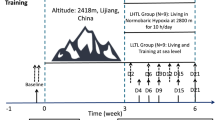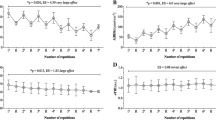Abstract
The purpose of this study was to investigate whether the modest increases in serum erythropoietin (sEpo) experienced after brief sojourns at simulated altitude are sufficient to stimulate reticulocyte production. Six well-trained middle-distance runners (HIGH, mean maximum oxygen uptake, V˙O2max = 70.2 ml · kg−1 · min−1) spent 8–11 h per night for 5 nights in a nitrogen house that simulated an altitude of 2650 m. Five squad members (CONTROL, mean V˙O2max = 68.9 ml · kg−1 · min−1) undertook the same training, which was conducted under near-sea-level conditions (600 m altitude), and slept in dormitory-style accommodation also at 600 m altitude. For both groups, this 5-night protocol was undertaken on three occasions, with a 3-night interim between successive exposures. Venous blood samples were measured for sEpo after 1 and 5 nights of hypoxia on each occasion. The percentage of reticulocytes was measured, along with a range of reticulocyte parameters that are sensitive to changes in erythropoiesis. Mean serum erythropoietin levels increased significantly (P < 0.01) above baseline values [mean (SD) 7.9 (2.4) mU · ml−1] in the HIGH group after the 1st night [11.8 (1.9) mU · ml−1, 57%], and were also higher on the 5th night [10.7 (2.2) mU · ml−1, 42%] compared with the CONTROL group, whose erythropoietin levels did not change. After athletes spent 3 nights at near sea level, the change in sEpo during subsequent hypoxic exposures was markedly attenuated (13% and −4% change during the second exposure; 26% and 14% change during the third exposure; 1st and 5th nights of each block, respectively). The increase in sEpo was insufficient to stimulate reticulocyte production at any time point. We conclude that when daily training loads are controlled, the modest increases in sEpo known to occur following brief exposure to a simulated altitude of 2650 m are insufficient to stimulate reticulocyte production.
Similar content being viewed by others
Author information
Authors and Affiliations
Additional information
Accepted: 7 October 1999
Rights and permissions
About this article
Cite this article
Ashenden, M., Gore, C., Dobson, G. et al. Simulated moderate altitude elevates serum erythropoietin but does not increase reticulocyte production in well-trained runners. Eur J Appl Physiol 81, 428–435 (2000). https://doi.org/10.1007/s004210050064
Issue Date:
DOI: https://doi.org/10.1007/s004210050064




